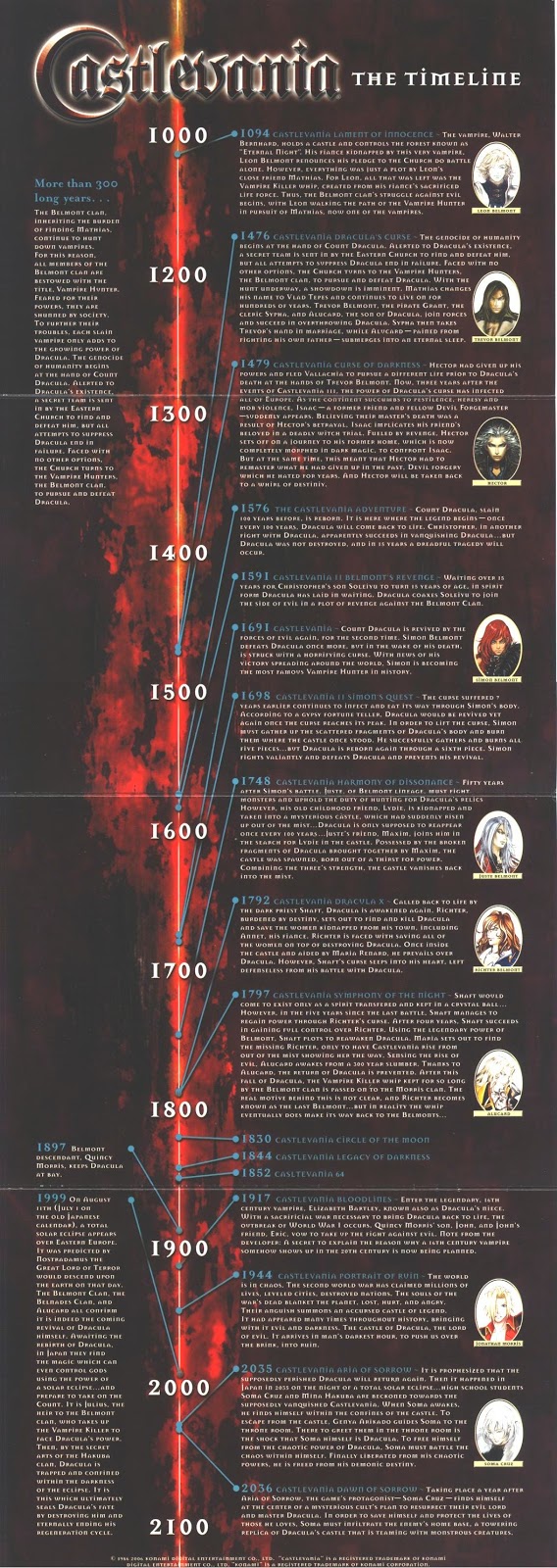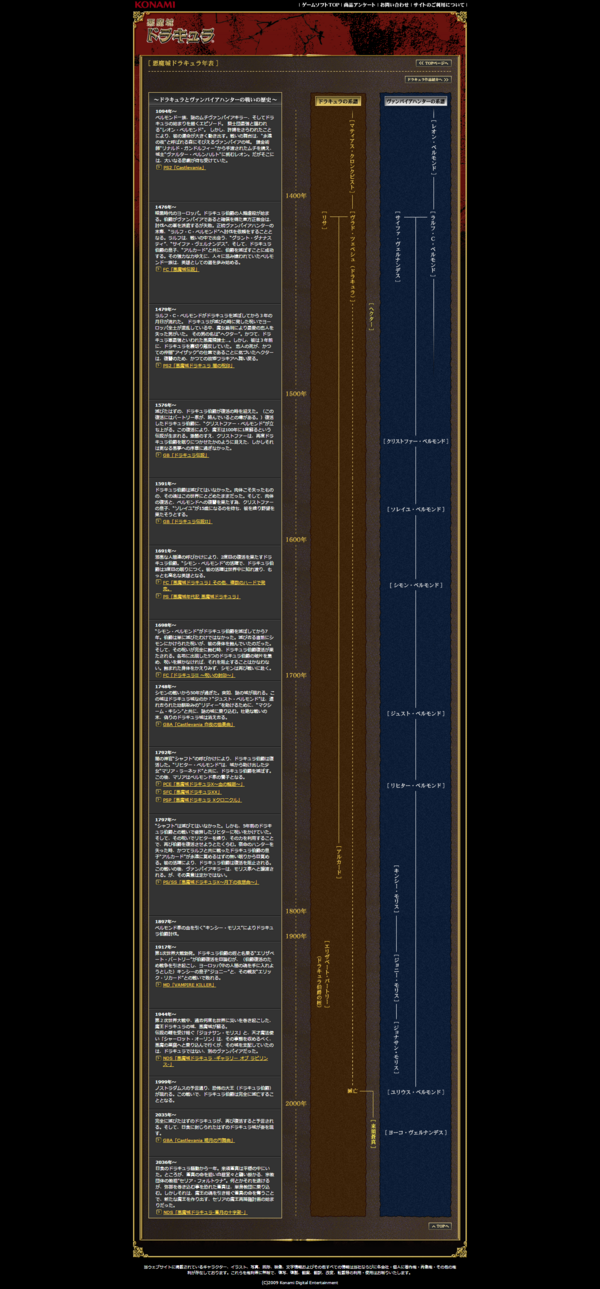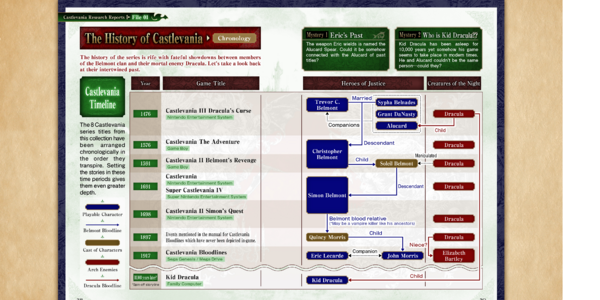
The official discord link if you wish to join the discord: https://discord.gg/j5RKwCvAFu
Support the wiki on our official Ko-Fi page or Patreon page!
Castlevania Timeline: Difference between revisions
From The Codex
| Line 170: | Line 170: | ||
[https://web.archive.org/web/20131215010925/http://www.chapelofresonance.com/articles/dave-cox.html They're directly noted in an interview with the lead developer], [https://web.archive.org/web/20131215010925/http://www.chapelofresonance.com/articles/dave-cox.html#:~:text=Is%20this%20game,is%20not%20connected. that the game has nothing to do with the canon, sharing none of the lore or original stuff for the characters]. | [https://web.archive.org/web/20131215010925/http://www.chapelofresonance.com/articles/dave-cox.html They're directly noted in an interview with the lead developer], [https://web.archive.org/web/20131215010925/http://www.chapelofresonance.com/articles/dave-cox.html#:~:text=Is%20this%20game,is%20not%20connected. that the game has nothing to do with the canon, sharing none of the lore or original stuff for the characters]. | ||
===Castlevania Netflix (Both | ===Castlevania Netflix (Both the original Netflix series and Castlevania: Nocturne)=== | ||
This series is an adaptation of both ''Castlevania III: Dracula's Curse'' and ''Castlevania: Rondo of Blood'', greatly differing from both of them with characters, events, and lore. | This series is an adaptation of both ''Castlevania III: Dracula's Curse'' and ''Castlevania: Rondo of Blood'', greatly differing from both of them with characters, events, and lore. | ||
Revision as of 15:44, 28 September 2024
Introduction
The Castlevania timeline is a very popular talking point within the Castlevania fandom. However, over the years there seems to be a lot of non-sourced information, mistranslated uses, usage of the English localization solely, or purposeful misinformation spread causing much confusion. The sake of this page is to use only what's officially shown within the games and officially sourced interviews to create a coherent timeline.
Addressing Retcons
The Castlevana series is not at all new to retcons. A prevalent one is with the Vampire Killer itself, although the current lore is that the Vampire Killer was meant to be a whip the Belmonts used that Richter passed down to the Morris to uphold a prophecy, the original canon were that there were 3 magical whips, with the Vampire Killer being the Morris' originally and the Belmonts holding the "Excaliber".
It should also be noted that since retcons like these exist, contradictions will exist within the given games as the lore was changed at points within the franchise. Mainly the whip and the Belmonts being a strong point to it.
There have also been timeline-related retcons and several timeline renditions. For this article, the timelines will be looked at but will not be considered definitive as the latest timeline of all the games predates the release of Castlevania: Judgement, a game all about the timeline, and it is not one-to-one with it.
Addressing Misconceptions
The following will be going over some popular misconceptions within the Castlevania community.
"Gaiden" means "Non-Canon" or "Alternate Timeline"
This stems from the belief that when Iga or a producer calls a Castlevania game a "Gaiden" it is therefore non-canon or an alternate timeline and can be dismissed. This, however, is not the case.
The term "Gaiden" merely just means a side story, spin-off, or a separate tale. The term "Gaiden" does not determine the canonicity of a work, it just lets you know if the game is a spin-off/side-story or if it's a main story. Take, for instance, the Kingdom Hearts series. Kingdom Hearts: Chain of Memories would be considered a gaiden, as it's a side-story and spin-off title that isn't a mainline numbered title, however, it is in all manners canon and important to play to understand Kingdom Hearts II.
The same can be applied to Castlevania itself, Castlevania Symphony of the Night is a gaiden game. Yet it is very obviously canon and pretty important to play to understand more of Alucard's backstory. The idea of a Gaiden game for the Castlevania series itself would be any game not dealing with one of Dracula's main 100-year-resurrections, which in this case, even Castlevania 2: Simon's Quest is in a way a gaiden, despite being completely canon.
This is all to say that Gaiden does not at all mean "non-canon" or "alternate timeline" and should never be treated as such, the term itself has nothing to do with the canonicity of a product.
IGA Statements Quoted by a Fan
Any statements Iga has made about Judgement that don't come from this IGN interview or a sourced and reputable article are not usable. This is, of course, referring to the popular statements used when discussing Judgement's Canoncity about a fan asking IGA about the game's Canoncity on Facebook, here are some of them below:
- Fan: You mentioned Legend of Cornell was an alternate continuity. However, Cornell appears in Castlevania Judgment, which I believe is not an alternate continuity. How does that work? is he from a different universe than the other characters? It is not really explained in the game itself so I was hoping you could give some clarification on the issue.
- IGA: Judgment is a work that surpasses space and time and brings them together.
- Fan: I get it. So, is the explanation I suggested in the previous reply possibly correct?
- IGA: I don't think it's exactly correct. Judgment is a work born of thinking it would be fun to remove all the hedges and bring characters that appeared throughout the series together. I think that you need to view it as an event from another world which does not consider things like timelines or parallel dimensions at all.
Now these seem like pretty clear-cut statements until you start to try to find where these come from.
They come from both a timeline archive discussion on the Castlevania Wiki back on January 15th, 2012 and from a forum post from the same user as the wiki article.
There is no way to find anything sourced or verifiably proven that this person spoke to Iga. Trying to look up the person didn't get any real results either.
Some other issues fall under the inconsistencies within these Iga talks, the person claims that Iga confirmed that Order of Shadows and the Arcade are non-canon because they were intended from the very beginning to be such, however, an officially sourced interview has the lead game designer of Order of Shadows state that Iga was actively involved with ensuring the game was consistent with the current canon, this would be a weird thing to do if he intended it to be non-canon from the very beginning.
He also claims that Iga said Super Castlevania IV was an alternate continuity, when the wiki also notes Iga saying that the games are all legitimate and the same scenario of defeating Dracula, however this quote is also unsourced, they just claim Iga says this with no link or anything.
There is another one not related to the user who spoke to Iga, but a user on reddit who claimed that a magazine claimed that Castlevania: Circle of the Moon was stated to be in a "different time axis". Attempting to get it translated got no wording that said anything like that, with it not even mentioning anything about canon, timeline, time axis, or any other wording of the sort in a machine-translated attempt. Do note however that this is a machine translation so it could potentially be that it is there, but until a reputable and verifiable translator can confirm or deny this translation, the jury is out with it and it will not be used for the canoncity of Circle of the Moon.
Thus all of these quotes are merely hearsay until shown or proven otherwise.
Remakes/Remasters Being Non-Canon
This comes from an Iga quote that says:
- "IGA: FC版とX68000版ですが、X68000版はFC版をベースにアレンジを加えたものになっています。ゲームのアレンジは、その時に応じて、色々と施されるものですので、正直どちらも正統であると思ってよいのではないかと思っています。結論として、ドラキュラと戦い勝つというシナリオで、中間部分の切り抜きが違うと考えてもよいのではないかと考えています。スーパーファミコン版も違いますし…。どうしてもと考えるのであれば、FC版を尊重すべきかと考えます。
- Translation: Regarding the Famicom version and the X68000 version, the X68000 version is an arrangement based on the Famicom version. The arrangement of a game is the kind of thing where you add a lot of different things as needed, so honestly speaking, it think they both should be considered legitimate. In conclusion, I think they should be considered as the same scenario of fighting to defeat Dracula, just with a different middle part. The Super Famicom version is different as well... If you simply must have a clear answer, the Famicom version must be given deference."
Now the quote itself doesn't state remakes or remasters are non-canon despite what people believe. It's moreso a quote of Iga stating that all of them are the same scenario, just with differences. However, an interesting point is that Iga says the NES version should be given "deference", as in to defer to the NES version.
Of course, though, this has the same issue as the Judgement quotes, everyone claims Iga said this, but there is no source of him saying this. In fact, in Castlevania Chronicles, there's a reward interview you receive from Iga himself where he talks about the game, Iga pretty much explains how the game came to be and never says anything about the game not being canon or to defer to the original[1], if anything he treats this as just an updated version of the original. Interestingly to note too, the original he's talking about is not Castlevania on NES but instead, he's talking about Vampire Killer on the MSX[2], though it borrows a lot of elements from Castlevania NES.
Overall due to the quote itself having no source, it is unusable. The way we will treat remakes, remasters, or ports here however is that they are all equally canon unless stated otherwise. Most of these tell the same story with the only real differences being extra background information added, such as Haunted Castle having it be Dracula stole Simon's wife, though the same overall story still applies even here. Iga himself has already expressed that the original Castlevania's story is pretty simple[3] and Simon having a wife does not affect anything in the overall narrative. Super Castlevania IV notes that Simon is a vampire, though this was due to a novel writer making him a vampire in their novel. The novel was originally supposed to be an adaptation of Super Castlevania IV but was then dropped and made its own thing. Super Castlevania IV itself is still canon, but the subplot of Simon being a vampire is not. The most recent timeline even acknowledges it as canon[4].
Iga Only Allows Stuff He Works on To Be Canon
There is a weirdly believed idea in the fandom that Iga only considers works he worked on canon, however, an officially sourced interview has the lead game designer of Order of Shadows state that Iga was actively involved with ensuring the game was consistent with the current canon, along with this Iga did not work on a lot of Castlevania games considered canon, such as the NES trilogy and the Gameboy games. In fact, he has only made 12 Castlevania games, out of the 30 Castlevania games in total, and most of them from the older console eras are still a part of the canon. Thus Iga does not only allow stuff he works on to be canon.
Iga is a Producer of Castlevania: Circle of the Moon
A Nintendo Power magazine calls Iga the producer of Circle of the Moon, with Iga talking like he worked on the game in that interview. However Iga can be found nowhere in the credits of the game. Making this Nintendo Power issue questionable as to if they were talking to Iga or if the game was mixed up. Though we have direct in-game proof that Iga was not a producer of Circle of the Moon.
The Timeline
1094 A.D. Castlevania Lament of Innocence
Dracula is not even Dracula yet within this game, he is Mathias and steals Walter's soul in order to gain his dark lord powers. Leon Belmont starts the legend of the Belmont Hunters being the ones to fight against the night. With the ending noting this the beginning of the Belmont clans struggle against evil. WitH Mathias and the Belmonts not meeting again for hundreds of years.
1470s A.D. Castlevania: Judgement Sypha
Sypha's story takes place years before the events of Castlevania III. It's even shown in Trevor's story she has no idea who Trevor is and Trevor notes she looks so young.
1476 A.D.[5] Castlevania III: Dracula's Curse
1476 A. D. Castlevania Curse of Darkness Manga
The events of the manga takes place during Dracula's war on humanity, which are the events of Castlevania III: Dracula's Curse.
1479 A. D. Castlevania: Judgement Trevor
This takes place several years after Trevor defeated Dracula. Trevor even notes to Grant it's been "many moons" since their last match. The same to Alucard. His ending shows this version is leading directly into the events of Curse of Darkness.
1479 A. D. Castlevania Curse of Darkness
Noted by Iga to take place three years after the events of Castlevania III.
1576 A. D.[6] Castlevania: The Adventure/Castlevania: The Belmont Legacy/Castlevania: The Adventure ReBirth
1591 A. D.[7] Castlevania II: Belmont's Revenge
Late 1600s Castlevania: Order of Shadows
1691 A. D.[8] Castlevania/Haunted Castle/Super Castlevania IV/Castlevania Chronicles/Haunted Castle Revisited
Iga explains the story pretty easily here, Simon, a descendant of the Belmont family, uses a sacred whip to destroy Count Dracula[9].
1692 A. D. Castlevania: Judgement Simon
The Simon from Judgement is after his fighting Dracula for the first time, along with taking six years before Simon learns of the curse placed on him.
1698 A. D.[10] Castlevania II: Simon's Quest
1748 A. D. Castlevania: Harmony of Dissonance
1792 A. D. Castlevania: Rondo of Blood/Castlevania: Dracula X/Castlevania: The Dracula X Chronicles
1795 A. D. Castlevania: Judgement Maria
This takes place several years after Maria aided Richter Belmont in defeating Dracula, with the story ending with next year Maria setting out in search of Richter and a year into her quest Castlevania suddenly reappearing, making this 2 years before Symphony of the Night.
1797 A. D. Castlevania Symphony of the Night
1798 A. D. Castlevania: Nocturne of Recollection (Radio Drama)
A year has passed since the events of Symphony of the Night[11].
1844 A. D. Castlevania: Judgement Cornell
Cornell's story takes place right before the events of Castlevania Legacy of Darkness.
1844 A. D. Castlevania: Legacy of Darkness
Initially the Nintendo 64 Castlevania games were removed by Iga, however Cornell and his story showed up in Castlevania: Judgement, with Iga stating in an interview for Judgement that all of the heroes are pulled from different periods of the Castlevania timeline, showing it's officially considered apart of the timeline as this goes past the 2007 Konami Japanese timeline, as Castlevania Judgement was released in 2008.
1852 A. D. Castlevania 64
Late 1800s A. D. Castlevania: Judgement Shanoa
Shanoa's story takes place during the events of Order of Ecclesia.
Late 1800s A. D. Castlevania: Order of Ecclesia
1897 A. D.[12] Castlevania Bloodlines: Game Manual
Events mentioned within the game manual of Bloodlines, are noted to take place here[13].
1907 A. D. Castlevania: Judgement Eric Lecarde
1917 A. D.[14] Castlevania: Bloodlines
1944 A. D. Castlevania: Portrait of Ruin
1999 A. D. The Big War
In the year 1999, Julius Belmont along with others seized Dracula's castle within a Solar Eclipse and killed him for good.
2035 A. D. Castlevania: Aria of Sorrow
2036 A. D. Castlevania: Dawn of Sorrow
2037 A. D. Castlevania: Requiem of the Divine Abyss
The events of this novel take place a year after Dawn of Sorrow.
10,000 Years Later[15] Kid Dracula
Not only does the most recent timeline even acknowledge it as canon[16]. Galamoth also appears in Symphony of the Night. There is also the fact that Galamoth is the final boss for Kid Dracula, where it's noted to be 10,000 years in the future. In Castlevania Judgement Aeon notes that is attempting to destroy an era to ensure Dracula's downfall with Aeon noting to Dracula that Time Repear is "a servant of he who hunts you from ten thousand years in the future, Aeon says something similar to Death during his story mode, with Time Reaper noting he comes from ten thousand years hence and calls out to Galamoth when he dies[17]. With this in mind Kid Dracula is apart of the timeline.
Events that Can't Be Given a Direct Year
Castlevania: Grimoire of Souls
The intro of the game shows that it takes place past all of the prior Castlevania games, even Dawn of Sorrow, where someone sent Genya Arikado a letter requesting his aid.
Castlevania: Harmony of Despair
Harmony of Despair is a game about all of the history recorded within the grimoire, this has no real timeline placement as it's all periods in the timeline.
Events that are Dubious Canon
These are events that have no real official word on their status and don't have an official time period to be able to decide for sure where they fall. These games are normally games released after Iga left Konami.
Castlevania: The Arcade
This game doesn't have any official time period, other than it being "a long time ago" in the country of Transylvania. Along with this, the main protagonists are kept purposefully vague. [https://youtu.be/xS2kC8fOppM?t=66 Vampire Hunter is noted to wield a whip and uses sub-weapons similar to the Belmonts/Belmont-adjacent families, but they never directly say he's a Belmont or that the whip is the vampire killer, it just most likely is that. Due to this purposeful vagueness, it's heavily likely that this is meant to be a canon game as it wouldn't make much sense to make a non-canon game kept this purposefully vague. As such it sits in dubious canon, as it likely did happen but there is not enough reference material to even know where or when it happened. This is perfectly usable on the profiles.
Castlevania Series that are alternate timelines
This covers games that are not a part of the main timeline of the Castlevania series, however, they are still canon and official. Consider these a part of the overall multiverse. Abilities and powers from these timelines should be able to be replicated in the main timeline due to this. To add on to this, these games were at one point officially a part of the original timeline before ultimately being removed. This is further supported by an interview in the History of Castlevania - Crescent of the Moon book, where executive producer of Castlevania Netflix Adi Shankar noted that even the "non-canon" games are parallel timelines in the overall multiverse, sharing the same spirit and lore[18]. While one could argue his statement shouldn't be used, it comes from a book titled, "History of Castlevania - Crescent of the Moon", where it wouldn't make much sense if his statement was wrong and there was no correction over it. The book even has asterisks to give further context, yet they never claim him wrong. Along with this, it's consistent with the fact that most of the Castlevania games that are "non-canon" now were originally a part of the timeline. Thus this statement is usable.
1830 A. D. Castlevania: Circle of the Moon
Although it was in the original 2006 timeline, it was removed by Iga from the timeline, along with Castlevania 64, Legacy of Darkness, and Legends.
Castlevania Legends
The game was originally meant to be a prequel to all the other games in the Castlevania series, this can be seen with Sonia's boss fight against Dracula serving as the first time Dracula ever encountered a Belmont along with the ending of the game saying "this story marks the beginning of the Belmont family legend that has been passed on through many ages". Along with this, Sonia shared a relationship with Alucard, heavily implying that her child is between her and Alucard. The existence of Lament of Innocence already greatly messes with this. The game manual even mentions that Sonia was the first of the Belmont family to leave her name to posterity as a vampire hunter[19]. Despite Leon Belmont being the one to start the legend of the Belmont Hunters being vampire hunters. Along with this, Trevor is canonically the first Belmont to defeat Dracula. Iga has gone out of his way to note too that Castlevania Legends was intentionally redacted from the timeline so that it doesn't conflict with the timing used in other titles.
Castlevania Series that are not Canon
Castlevania Lords of Shadows
They're directly noted in an interview with the lead developer, that the game has nothing to do with the canon, sharing none of the lore or original stuff for the characters.
Castlevania Netflix (Both the original Netflix series and Castlevania: Nocturne)
This series is an adaptation of both Castlevania III: Dracula's Curse and Castlevania: Rondo of Blood, greatly differing from both of them with characters, events, and lore.
Conclusion
This page will sometimes receive updates or try to explain more in depth the events, though this is a page that goes over the full timeline using official sources and verifiable proof.
References
- ↑ Castlevania Chronicles
- ↑ Castlevania Chronicles
- ↑ Castlevania Chronicles
- ↑ Castlevania Anniversary Collection Bonus Book Pages 29-30
- ↑ Castlevania Anniversary Collection Bonus Book Pages 29-30
- ↑ Castlevania Anniversary Collection Bonus Book Pages 29-30
- ↑ Castlevania Anniversary Collection Bonus Book Pages 29-30
- ↑ Castlevania Anniversary Collection Bonus Book Pages 29-30
- ↑ Castlevania Chronicles
- ↑ Castlevania Anniversary Collection Bonus Book Pages 29-30
- ↑ Castlevania Nocturne of Recollection
- ↑ Castlevania Anniversary Collection Bonus Book Pages 29-30
- ↑ Castlevania Anniversary Collection Bonus Book Pages 29-30
- ↑ Castlevania Anniversary Collection Bonus Book Pages 29-30
- ↑ Castlevania Anniversary Collection Bonus Book Pages 29-30
- ↑ Castlevania Anniversary Collection Bonus Book Pages 29-30
- ↑ Castlevania Judgement Dracula True Story Mode
- ↑ History of Castlevania - Crescent of the Moon Pages 34 - 37
- ↑ Castlevania Legends Game Manual Pages 2 & 12


